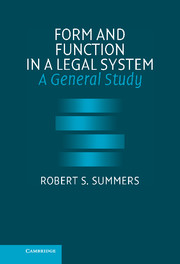Book contents
- Frontmatter
- Contents
- Preface
- Acknowledgments
- PART ONE INTRODUCTION, BASIC CONCEPTS AND DEFINITIONS, AND A GENERAL APPROACH
- PART TWO THE FORMS OF FUNCTIONAL LEGAL UNITS
- PART THREE THE OVERALL FORM OF A LEGAL SYSTEM AND ITS OPERATION
- 10 The Overall Form of a Legal System as a Whole
- 11 Cumulative and Synergistic Effects of Legal Forms – A Schematic Practical Application
- Name Index
- Subject Index
10 - The Overall Form of a Legal System as a Whole
Published online by Cambridge University Press: 29 July 2009
- Frontmatter
- Contents
- Preface
- Acknowledgments
- PART ONE INTRODUCTION, BASIC CONCEPTS AND DEFINITIONS, AND A GENERAL APPROACH
- PART TWO THE FORMS OF FUNCTIONAL LEGAL UNITS
- PART THREE THE OVERALL FORM OF A LEGAL SYSTEM AND ITS OPERATION
- 10 The Overall Form of a Legal System as a Whole
- 11 Cumulative and Synergistic Effects of Legal Forms – A Schematic Practical Application
- Name Index
- Subject Index
Summary
“The concept of law includes … two elements; a system of purposes, and a system of their realization.”
– R. von JheringINTRODUCTION
The legal system of a developed Western society includes a vast heterogeneous array of what may be called “first-level” functional legal units. These varieties take their own overall forms, and have their own constituent formal features, with complementary material and other components. In Chapters Four through Nine, we considered a selection of major varieties of such functional units: institutions of a legislative nature, precepts consisting of rules, nonpreceptual law including contracts and certain property interests, interpretive methodologies, and sanctions and remedies. We now turn to how what I will call various “second-level” systematizing devices organize these first-level units (and still others) into the overall form of a legal system as a whole. The overall form of this resulting system is itself a highly complex purposive systematic arrangement designed to govern in accord with law a population typically residing in a geographically contiguous area. The system-wide material and other components of this complex system include this population and this geographical area. H. L. A. Hart stressed that such a system as a whole includes a characteristic minimum of first-level “primary” rules in due form with content protecting persons, property, and promises. As I have emphasized, Hart should have stressed that the first level here also characteristically includes many other major varieties of functional legal units besides rules.
- Type
- Chapter
- Information
- Form and Function in a Legal SystemA General Study, pp. 305 - 350Publisher: Cambridge University PressPrint publication year: 2005



